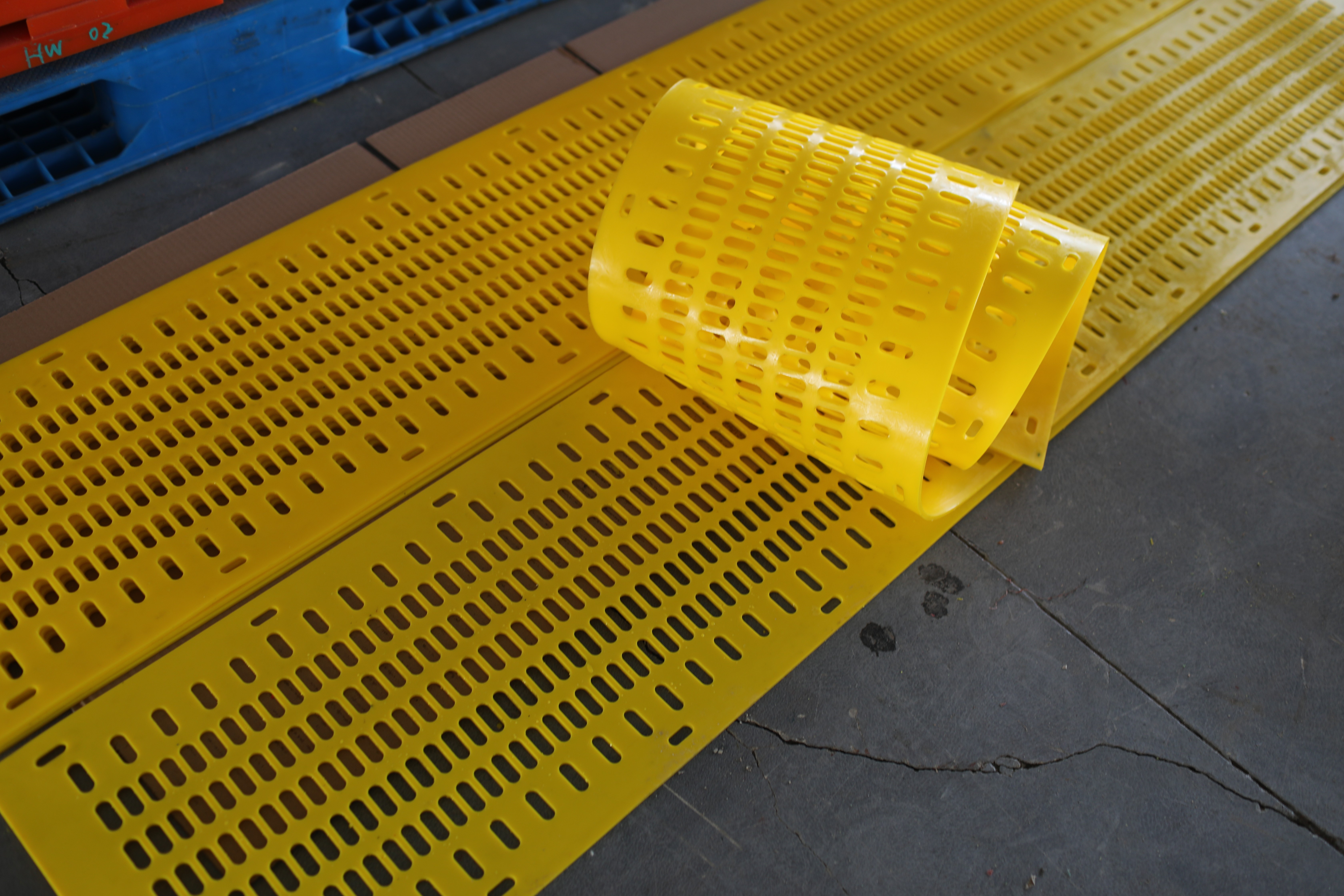Understanding Flip Flop Screen Mesh Technology
How Flip Flop Mesh Mechanics Enhance Screening Dynamics
Flip flop mesh tech works differently from standard screening methods because it uses nonlinear vibrations instead of straight back-and-forth motion. What makes this approach so effective is how it moves materials across the screen surface in a way that actually boosts production rates while cutting down on damage to the screen over time. The special flip flop setup helps sort out different sized particles too. Small stuff goes right through the gaps but bigger pieces get caught and stay behind, which means better overall separation results. These screens really shine when dealing with tough materials that would give regular vibrating screens a hard time, making them a smart choice for many industrial applications where reliability matters most.
Material Science Behind High-Performance Screen Surfaces
Picking the correct materials for flip flop screen surfaces matters a lot since they face pretty harsh working conditions day in and day out. Polymers with good tensile strength along with certain types of elastomers work really well because they hold up better against abrasion and last longer than other options. Some studies have shown that using composite materials actually makes those screen meshes more flexible while still keeping them strong enough for heavy duty applications. When screens last longer between replacements, it means better overall performance and saves money on repairs down the road. Most manufacturers now take this kind of material science seriously when designing their equipment, which helps keep operations running smoothly even when dealing with difficult screening tasks.
Critical Design Features for Aggressive Material Handling
Flip flop screen systems come with some pretty important design elements that make them work well with heavy stuff and those really rough, abrasive materials most other equipment struggles with. The frames on these systems need to be tough because they take all the pounding from material impacts while spreading out the weight across the whole structure. We've seen this kind of durability matter a lot when dealing with things like crushed stone or industrial waste products that would tear through weaker constructions. Another thing that makes maintenance easier? Those adjustable screen angles combined with fast release mechanisms so technicians can get into the system quickly without wasting time dismantling everything just to do routine checks. All these built-in features mean operators spend less time fixing problems and more time getting actual work done, which is what matters most in any production environment.
Optimizing Aggregate Screening Throughput with Flip Flop Systems
Balancing Stroke Length and Amplitude for Maximum Efficiency
Getting good results from aggregate screening really comes down to finding the right mix between stroke length and amplitude settings. These two factors work together in ways that have a big impact on how well materials separate and how much can pass through the screen at once. When the stroke length is set properly, it helps different sized particles spread out better across the screen surface, which makes everything run smoother during operation. Field tests show that when operators take time to adjust stroke lengths based on what kind of material they're dealing with, the screening process works noticeably better, meaning more material gets processed in the same amount of time while still maintaining quality standards.
The Impact of Surface Inclination on Material Flow Rates
The angle at which a screen sits plays a big role in how materials move through screening operations. When screens are set at the right slope, materials tend to flow better across them without getting stuck or clogged up. Studies show changing this angle can actually change how fast materials pass through by more than 20 percent, so getting this right matters a lot when designing screens. Steeper angles generally let stuff pass through quicker while flatter setups might slow things down quite a bit, which impacts how well the whole system works. Getting the inclination just right remains essential for keeping those flow rates optimal and avoiding problems on the production line.
Comparison: Flip Flop vs. Linear Vibrating Screen Performance
Comparing flip flop screens against traditional linear vibrating screens means looking at several important factors including how well they work, how fast they wear down, and what kind of maintenance they need over time. Flip flop systems generally perform better when dealing with sticky or wet materials, something where they beat linear vibrating screens quite handily in most cases. The reason for this lies in their special design features and the way they operate, allowing them to screen materials more effectively even under tough conditions. Looking at all these aspects helps operators pick the right screening tech for their particular situation without wasting resources on something that won't fit their requirements.
For a deeper understanding of flip flop screen technology, you might compare similar systems, such as the reliable linear vibrating screen, to see firsthand how distinct factors influence operational performance.
Key Factors Influencing Screening Efficiency
Particle Size Distribution and Its Effect on Throughput
Getting a good grasp on particle size distribution matters a lot when trying to get better screening results. When particles vary in size, it really affects how fast things move through the system because bigger particles just won't go through the same mesh as smaller ones. Take it from experience, if screens are set up properly for specific particle sizes, some plants have seen their output jump around 30%. That's why looking at what kind of particle sizes we're dealing with before setting up screens makes all the difference. Screens that match the actual material mix being handled tend to work much better overall, which means less downtime and more productive runs across different processing operations.
Humidity Control Strategies for Sticky Aggregates
Keeping humidity under control matters a lot when dealing with sticky aggregates that tend to stick together and clog up screening machines. When these materials get too damp, they form big lumps that jam everything up. One way to handle this issue is through air drying methods or by installing dehumidifiers around the processing area. This helps cut down on all those problems caused by excess moisture during material handling operations. Controlling humidity means sticky stuff won't mess up the screening operation so much, keeping things running smoothly most of the time. Besides avoiding costly equipment stoppages, proper humidity management actually makes the whole screening process work better in real world conditions where variables constantly change throughout the day.
Mitigating Blockage Risks in High-Capacity Operations
For big scale operations, spotting where things might get blocked and putting plans in place to stop problems is really important for keeping everything running without stopping. Checking screening equipment on a regular basis makes all the difference because it helps catch small issues before they turn into major headaches that shut down whole operations. Many facilities now install special anti-block tech which works wonders for making sure screens keep doing their job properly. When companies actually put these methods into practice, most find their large scale work flows much better day to day while saving money on those expensive unexpected stops.
Operational Strategies for Peak Flip Flop Mesh Performance
Optimizing Deck Configuration for Specific Aggregate Types
Getting the deck configuration right for different types of aggregate really matters when it comes to making flip flop screens work at their best. When operators take time to customize these settings properly, they see better results from the screening process and get cleaner material separation too. Looking closely at what kind of aggregate needs processing and using some good data analysis helps create deck setups that actually make a difference. We've seen real improvements in how much material gets through the system per hour, which cuts down on running costs over time. Some field tests showed that properly configured decks could boost throughput by around 25% in gravel processing plants, something that translates directly into bottom line savings for most operations.
Implementing Preventive Maintenance Routines
Setting up regular maintenance for flip flop screens really pays off in the long run. Not only does it keep them running reliably for years, but it also cuts down on those expensive emergency repairs we all hate dealing with. Most good maintenance plans include checking things at set intervals and doing whatever needs doing to stop small problems from becoming big ones. Some facilities are now using fancy data analysis tools to spot trouble spots before they actually cause downtime. While nothing beats hands-on inspection every so often, these digital helpers definitely catch stuff our eyes might miss. Making time for routine checks, fixing what needs fixing when it's still manageable, and generally staying ahead of the curve with maintenance work goes a long way toward keeping these important parts of our equipment working properly for much longer than expected.
Advanced Monitoring Techniques for Real-Time Adjustments
When advanced monitoring tech gets put into place, it gives operators the power to tweak the screening process as things happen. What does this mean? Well, problems get spotted early on and fixed before they turn into bigger headaches down the road. For those flip flop screens specifically, adding IoT solutions brings some serious data analysis potential. Operators start seeing what's actually happening with screen performance metrics and can make smart choices when needed. Sensors and all sorts of monitoring gear let folks keep an eye on those machines around the clock. They watch things like temperature fluctuations, pressure changes, and other key indicators. This constant tracking helps fine tune how everything runs while keeping sustainability goals in mind for the long haul.
Future Trends in Aggregate Screening Technology
Smart Screening Systems with Automated Parameter Adjustments
Smart screening systems that automatically adjust parameters are changing how aggregate processing works today. These new technologies boost efficiency on factory floors while cutting down on the hands-on work required from operators. With companies across manufacturing constantly looking to squeeze more output from their equipment and reduce reliance on workers for routine adjustments, smart screening tech might just rewrite the rulebook for standard operating procedures. What makes these systems special is their ability to tweak settings as conditions change during operation. Real time data analysis lets them optimize everything from throughput rates to material quality without needing someone to manually fiddle with controls every few hours.
Integration of Flip Flop Technology with Hybrid Screening Solutions
Bringing flip flop tech into hybrid screening setups opens up some pretty exciting options for dealing with all sorts of materials while making operations much more flexible. We know flip flops work great on those tough materials that normally give screening headaches. When paired with hybrid systems, they really boost what these machines can handle. Looking ahead, we should see some interesting improvements in how much stuff gets processed and how well it works overall. Companies adopting this combo will find themselves better equipped to tackle different kinds of materials without breaking a sweat, which means their day to day running becomes smoother and more productive across the board.

